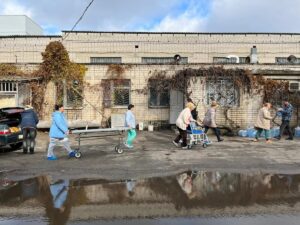Six ways the war in Ukraine has impacted children
It is no surprise that the conflict in Ukraine has had devastating impacts on children over the past year. More than 1,000 children have been killed or injured while millions of others have fled thousands of miles from their homes or been forced to seek safety in bunkers for days on end. No experience is exactly the same, however they are experiences no child should have to face.
Below are six ways this horrific war has severely impacted the children of Ukraine.
1. Child Casualties
A pile of teddy bears placed outside a destroyed apartment building in Dnipro symbolizes the constant danger facing children in Ukraine. The building was blown apart by a missile in January killing six children and injuring 126 people. Grave danger faces children at every turn. According to the UN, as of February 6th 2023, 438 children in Ukraine have been killed since the conflict began along with 851 injuries.

Mourners in Dnipro placed toys, flowers, and candles at a bus stop near the apartment block that was destroyed by the missile strike (Vladyslav Garnaiev/Save the Children)
2. Mental health impacts
The constant threat of missile and artillery strikes as well as daily sirens is having a profound effect on the mental well-being of children in Ukraine. Psychosocial support is essential to help prevent long-term trauma. Save the Children has set up ‘child-friendly spaces’ across Ukraine, where children can play, socialize, relieve stress and feel like children again. Save the Children also trains staff to conduct therapy sessions with pets. Parker the golden retriever (see photo) was an instant hit with children in communities near the capital city, Kyiv.

Viktoriya*, 9, poses with golden retriever Parker, a two-year-old therapy dog, during a dog therapy session at a school outside of Kyiv, Ukraine (Oleksandr Khomenko/Save the Children)
3. Forced underground
Persistent air strikes and explosions are forcing millions of children underground. In fact, Save the Children calculates that the average child spent approximately 900 hours underground – about 40 days – in bunkers and other subterranean spaces last year. To help children in bunkers maintain some sense of normalcy, Save the Children has distributed psychosocial bunker kits to families across Ukraine. They contain toys, games, arts and crafts to promote learning. They also have mental health activities to help children manage stress underground while shelling continues overhead.

‘Psychosocial kits’ for children to play with when they are sheltering underground from missiles in Ukraine (Save the Children)
4. Schools and hospitals under fire
On average, four schools have been destroyed or damaged every day in the past year, according to data published by the Ukraine Ministry of Education and Science, and there have been 764 attacks on health care facilities since conflict escalated as of February 6 2023. Schools close to the areas of active fighting did not reopen in September. Save the Children is establishing Digital Learning Centres and distributing Education Kits with stationery, so children can continue with their studies both online and in-person. In addition, medical equipment and supplies are provided to hospitals and mobile health teams, with a particular focus on maternal and newborn health.

A hospital in Kherson, Ukraine, which has had much of its equipment looted (Save the Children)
5. Families separated
The onslaught of war means millions of children have had to flee, saying goodbye to loved ones and leaving their familiar lives behind. Over six million people within Ukraine are currently displaced, while almost eight million refugees have fled to Europe. Far from home and separated from friends and family, refugees are struggling with their mental health. A survey by Save the Children found that 44% of refugee children in Europe are feeling lonely, while 55% are worried about their future.

Polina* and her family (aside from her Grandmother) left Ukraine for the United Kingdom. Polina* wanted to continue studying via online classes at her Ukrainian school, but she was unable to do so because of the constant power outages in Ukraine.
6. Poverty
Fuelled by war and rising inflation, poverty across eastern Europe and Central Asia soared by 19% this year, according to UNICEF, while the conflict has dragged an additional half a million children in Ukraine beneath the poverty line. Hardship for children in Ukraine has worsened due to dwindling harvests – 40% of land assigned to wheat cultivation has been destroyed, causing economic problems at home, while endangering the lives of millions of children in Africa who rely on the grain for survival.

Over the past year, over 18,000 civilians have been injured or killed in Ukraine. Despite this grim picture, children hold onto hope. With their families, children are pulling together and showing tremendous resilience.
Save the Children will continue to work tirelessly to lessen the impact of war on children and also demand places like schools, hospitals, and homes – do not become battlegrounds.
To support the children in Ukraine please click here.


